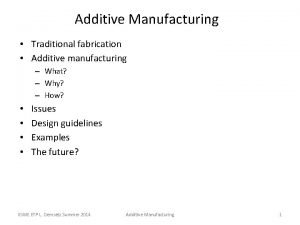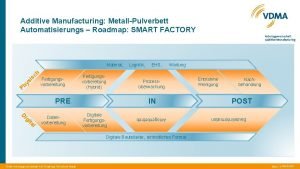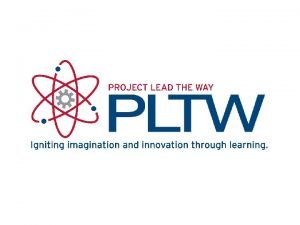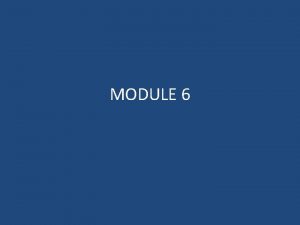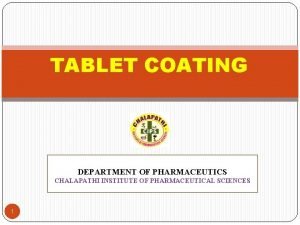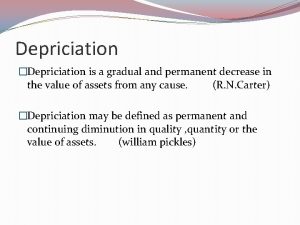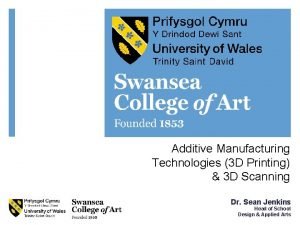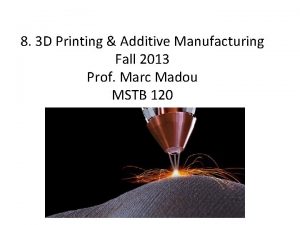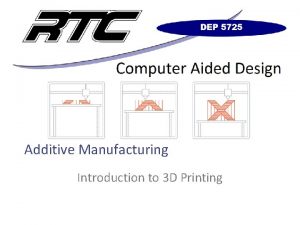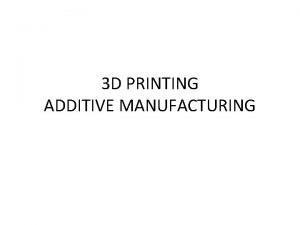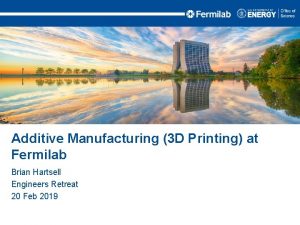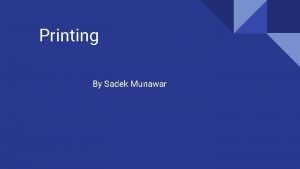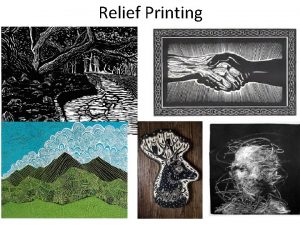Additive Manufacturing Also known as 3 D printing












- Slides: 12


Additive Manufacturing Also known as 3 D printing, is a process that creates a physical object from digital design. It’s a transformation approach to industrial production that enables creation of lighter, stronger parts and systems. AM can bring digital flexibility and efficiency to manufacturing operations.

AM uses data CAD software or 3 D object scanners to direct hardware to deposit material layer by later in precise geometric shapes. As indicated, adds material to create an object. 3 D printing and rapid prototyping are actually subset of AM.

Working: • AM refers technologies that grow 3 D object one superfine layer at a time. • Each successive layer bonds to the preceding layer of melted or partially melted material. • Possible to use different substances for layering material, including metal powder, ceramics, composites, glass and even edibles like choclate. • Objects are defined digitally by CAD software • It’s the st. files that slice the object into ultra thin layers • This info guides the nozzle/print head as it precisely deposits material upon the preceding layer

• A laser/electron beam melts/partially melts in a bed of powdered material • As material cools or are cured, fuse together to from 3 D object

AM processes: • Material extrusion: spooled polymers are extruded/drawn through a heated nozzle mounted on a movable ram. • Direct energy deposition: similar to material extrusion, an electron beam gun/laser mounted on a 4/5 axis arm melts either wire/filament feedstock/powder • Material jetting: print head moves back and forth. It moves on x, y and z axis to create 3 D object. The layers hardens as they cool or cured by ultra-violet light.

• Binder jetting: similar to MJ but that print head lays down alternate layers of powdered material and a liquid binder. • Sheet lamination: Laminated object manufacturing ( LOM ) uses alternate layers of papers and adhesives while Ultra sonic AM uses thin metal sheets conjoined through ultrasonic welding. Ultrasonic AM – low temperature, low energy process. Vat polymerization: Object is created in a vat of a liquid resin photopolymer; - Process called photo polymerization cures each micro-fine resin layer using ultra violet light precisely directed by mirrors.

• Powder bed fusion: Direct metal laser sintering Selective heat sintering Electron beam melting Direct metal laser melting - Uses lasers, electron beams to melt/partially melt ultra fine layers of material in a 3 D space. - Excess powder is blasted away from the object.




Applications: Has been used across diverse array of industries, including: bio-medical aerospace automotive sector
 Additively
Additively Additive manufacturing
Additive manufacturing Additive manufacturing
Additive manufacturing Solid
Solid Job costing and process costing
Job costing and process costing Commited cost
Commited cost Manufacturing cost vs non manufacturing cost
Manufacturing cost vs non manufacturing cost Manufacturing cost vs non manufacturing cost
Manufacturing cost vs non manufacturing cost Also known as axial movement
Also known as axial movement Koettsdorfer number is also known as
Koettsdorfer number is also known as What is equal sharing and equal grouping
What is equal sharing and equal grouping Opaquant example
Opaquant example Fixed installment method and diminishing balance method
Fixed installment method and diminishing balance method

